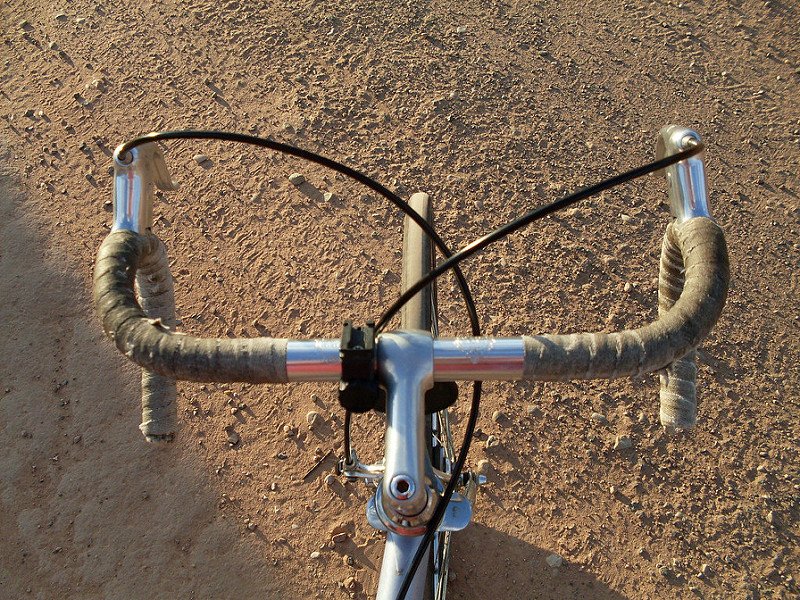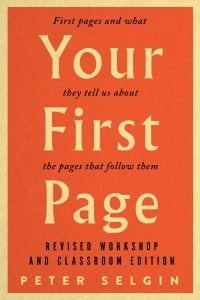
Today’s post is by regular contributor Peter Selgin, the award-winning author of Your First Page. He offers first-page critiques to show just how much useful critical commentary and helpful feedback can be extracted from a single page—the first page—of a work-in-progress. Learn more about getting a first-page critique.
First Page
Mom told me just yesterday not to ever leave the Lovin’ Cup Cafe at nightfall. That even in the tiny city of Pleasantville, nestled up against the Canadian border, strange things can happen as night descends. Note to self: listen to Mom more often.
I watch as Jeff McKinney and Ralph Jones walk into the triangle of light formed by the street lamp next to the road and pause. I walk back into the alcove formed by the handicapped ramp as it rises to meet the cafe’s entrance.
“Well, look what we have here,” Jeff says, smiling right at me and then at Ralph, who smiles back at Jeff like he always does.
I slip my hands into my jacket pockets so they can’t see they’re shaking.
“If it isn’t Jamie Domedian,” Jeff says, pronouncing my last name so it rhymes with comedian. It doesn’t, but I won’t correct him.
Tonight is a first. I’ve never been alone with these two. Their harassment always takes place in crowded school hallways or waiting in line for the bus ride home.
As they walk toward me, I take another step back and feel my thigh up against the wheel of my ten-speed. I do a half-turn, insert the key into my bike lock, and yank the lock cord free, stuffing it in my pocket.
“Don’t you two have cows to milk back at the farm?” Everyone knows McKinney and Jones live miles from here in cow town with all of their farmer neighbors.
Turn the handlebars toward the parking lot. Run, left foot on the pedal, sit on the saddle, and go!
It’s a grand exit until McKinney makes a lunge and grabs the center of the handlebars.
“We’re not here to talk farming,” Jeff says.
First-Page Critique
Now and then my students and I broach the unavoidable question: What makes a work of art? The question can be stood on its head: What makes art work? They’re the same question, really, with (to me, anyway) the same answer: a true work of art is something that doesn’t merely elicit our emotions—as any Hallmark card will do. It confronts us with emotions that don’t quite fit into any of our ready-made boxes.
A simple but good example of this may be found in Jasper Johns’ famous painting of the United States flag. From a distance it looks like any U.S. flag, but step closer and you see the heavy impasto strokes of encaustic (wax) paint. It’s not a U.S. flag; it’s a painting of the U.S. flag. A flag is a symbol; it has a utilitarian purpose. It represents a nation. It’s no more open to interpretation than (for most drivers, anyway) a stop sign. By converting it through an unusual medium and removing it from ordinary contexts, Johns’ painting of the flag opens it up to interpretation. It no longer merely denotes. It connotes. It suggests feelings beyond its literal meaning.
Complicating our feelings: that, to me, is art’s highest purpose.
Which may seem a highfalutin approach to discussing this first page of a young adult novel in which a boy is menaced by two bullies, but the fact is that, in its humble way, this first page does what great art does: it complicates our feelings by confronting us with an unstable blend of danger and humor.
The opening sentence (“Mom told me …”) establishes not only the youthful narrator’s voice, but the setting—both time and place—while foreshadowing conflict: something bad has transpired at the Lovin’ Cup Cafe at nightfall. By saying “Mom” rather than “My mother,” the narrator instantly establishes intimacy with his readers, an intimacy that bonds us to him before we set eyes on his nemeses.
The next sentence of this deft opening nails down the location: not only the size (“tiny”) of the small-town setting, but its situation “nestled up against the Canadian border.” The last sentence of the paragraph drives home the foreboding hinted at in the first, and does so wittily via a note to the narrator’s “self.” Dangerous humor; humorous danger.
Having established setting both generally (tiny city near Canada) and specifically (cafe at nightfall), the author paints an exterior street scene with a few expressionistic strokes, the “triangle of light” from a “street lamp,” and the more specific “alcove formed by the handicapped ramp”—a detail that, because it’s so specific, adds gritty authenticity. We have all we need now to form a solid picture and inhabit this scene.
The first two paragraphs having engaged our sense of vision, with the third paragraph a snatch of dialogue (“Well, look what we have here”) pricks up our ears. However tinged with cliché (and—let’s face it—bullies are clichés), the words offer their own touch of menace, as does the smile that goes with them and that Bully #2 mirrors. (If there’s one thing worse than an antagonist, it’s a smiling antagonist.)
The next paragraph treats us to yet another authenticating touch: how the protagonist’s name isn’t pronounced. Note how this is delivered not as a piece of inert information, but through a dramatic moment, an active description. It’s also ironic in ways that are, again, equally funny and dangerous. Though his name may not rhyme with one, Jamie is something of a comedian. His sense of humor puts him at risk.
Lest we wonder if we might be dealing with routine, Paragraph #6 (“Tonight is a first”) smashes that. What we have here is an event, an inciting incident: something that breaks with routine (“I’ve never been alone with these two”). The next sentence contextualizes the routine against which this exceptional event occurs. It gives us a frame of reference for the bullying that, apparently, has been going on for some time.
The next paragraph has the narrator backing into his bike, feeling “his thigh up against its wheel.” In the movie version, this is one of those moments when the audience gasps and jerks up in their seats. Without needing to be told, we imagine the narrator’s nearly simultaneous responses: first, the shock of being touched by someone/something he didn’t know was there; then relief on realizing it is his means of escape.
Next paragraph, first line: “Don’t you two have cows to milk back at the farm?” Like all good dialogue, it does double-duty: evokes character while carrying information. From this one line we know that (a) however dangerous they are, wise-ass Jamie doesn’t have much respect for his enemies; and (b) our two bullies live in the boonies.
 Next: “Turn the handlebars toward the parking lot. Run, left foot on the pedal, sit on the saddle, and go!” Why simply describe a series of actions (“I turned my bike around and pedaled out of the parking lot”) when you can describe them so they convey character? Remember: whatever we do that evokes character is probably a keeper. My one quibble here is that I’d eliminate pronouns and conjunctions: “Turn handlebars toward parking lot. Run. Left foot on pedal, sit on saddle. Go!”
Next: “Turn the handlebars toward the parking lot. Run, left foot on the pedal, sit on the saddle, and go!” Why simply describe a series of actions (“I turned my bike around and pedaled out of the parking lot”) when you can describe them so they convey character? Remember: whatever we do that evokes character is probably a keeper. My one quibble here is that I’d eliminate pronouns and conjunctions: “Turn handlebars toward parking lot. Run. Left foot on pedal, sit on saddle. Go!”
I’ve said more than enough. Humor and danger on the same page—what more can we ask for? This opening got me. Has it got you?
Your turn: How would you assess this opening? (Be constructive.)
Peter Selgin is the author of Drowning Lessons, winner of the Flannery O’Connor Award for Short Fiction (Univ. of Georgia Press, 2008). He has published a novel, Life Goes To the Movies (Dzanc, 2009), three books on the craft of fiction writing (Writer’s Digest, Serving House Books, Broadview Press), and a children’s picture book, S.S. Gigantic Across the Atlantic (Simon & Schuster). His first essay collection, Confessions of a Left-Handed Man (University of Iowa, 2012), was a finalist for the William Saroyan International Prize. A novel-in-manuscript, “The Water Master,” won the Faulkner-Wisdom Prize for Best Novel. His memoir, The Inventors (Hawthorne Books), which won the Housatonic Book Award, was among Library Journal’s Best Nonfiction Books of 2016. He is Associate Professor of English at Georgia College & State University. Find out more at his website.

I like how you underlined the mix of humor and danger to engage the reader. I am hooked and want to know what happens next.
Really valuable ideas, very much something to think about. I bought Peter’s book, it is worth the time and money. I’m just a writer, not a paid spokesperson…..
Best first page you’ve offered in some time, and every paragraph of your critique illuminated the writing for me. Thank you.
By the end of this opening, fear, protectiveness, witnessing bravery, and despair that Jamie was facing a foe too overwhelming — and wishing for rescue — perhaps even one that created fear in the whole trio…were all experienced, at the least.
My only concern was that I was unsure how close the bullies were — that’s just my practical view — and it wasn’t clear to me that he had time to unlock his bike and escape. It also wasn’t clear that he had an opening, a direction to travel, that was at right angles or in the opposite direction from the bullies. So, it was startling that the one bully managed to stop Jamie by grabbing the center of his handlebars. This would mean he had been able to get in front of him, right?
As mentioned, this is my practical view, which forces logistics to become important. I am already deep in the situation, but when Jamie is ‘caught’ I feel cheated a bit — the escape is foiled, but I had no chance to envision this possibility, and am now forced to believe that Jamie also saw no possibility of it. This is frustrating a bit because it forces me to make assumptions about this protagonist, assumptions that conflict with who I felt he was/is.
Really enjoyed it though, and would read on — already championing this brave young man.
Thanks, Peter, for your ever-insightful thoughts.